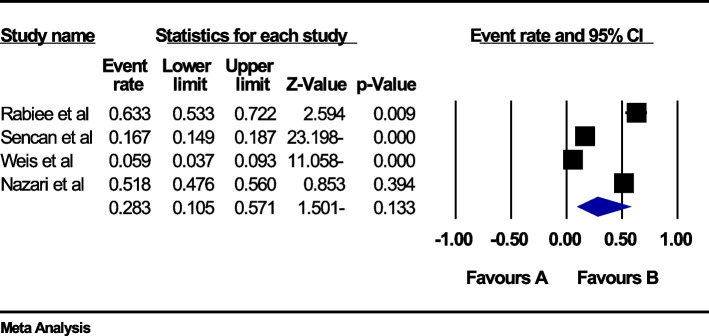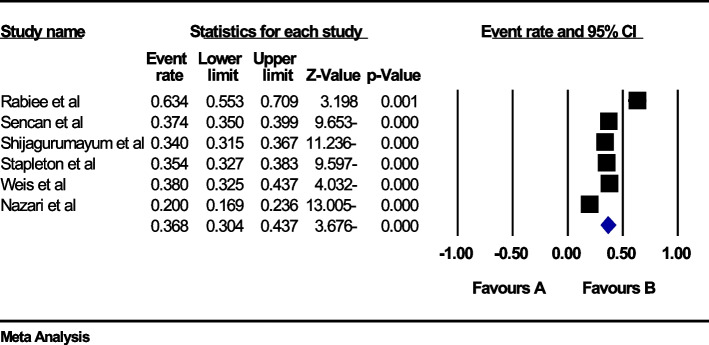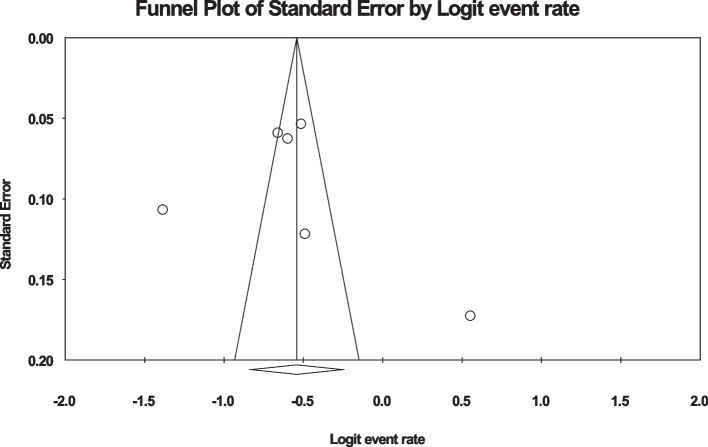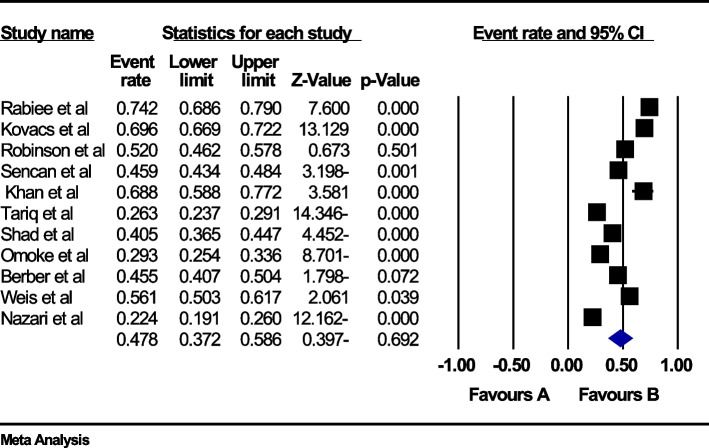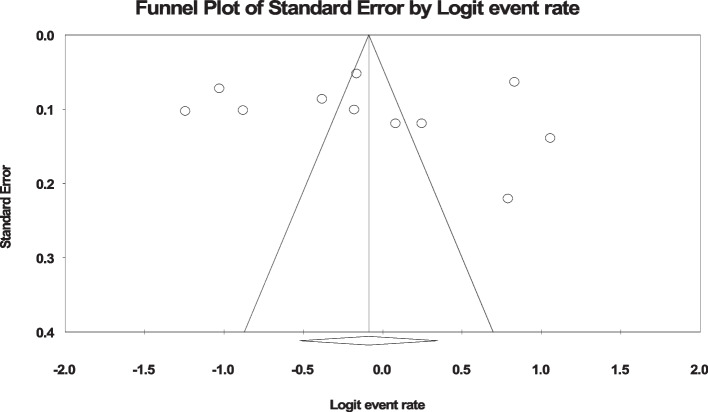Abstract
Background
Back pain during pregnancy is often considered as an unavoidable problem and can reduce the quality of life or disability of pregnant women. The aim of this study is to determine the global prevalence of back pain in pregnancy based on a systematic review and meta-analysis.
Methods
In this study, Researchers systematically searched electronic databases PubMed, Scopus, Web of Science, Embase, ScienceDirect, and Google Scholar search engines for studies until September 2023. To analyze data, the random effects model was used, and the heterogeneity of the studies was checked with the I2 index. Data analysis was performed by software (Version 2 Comprehensive Meta-Analysis).
Results
In the review of 28 studies with a sample size of 12,908 people, the I2 heterogeneity test showed high heterogeneity (I2: 98.4). Based on this, the random effects method was used to analyze the results. Therefore, the meta-analysis reported the global prevalence of back pain at 40.5 (95% CI: 33–48.4) during pregnancy. Also, according to the meta-analysis, the global prevalence of back pain in the first trimester of pregnancy is 28.3 (95%CI: 10.5–57.1), in the second trimester is 36.8 (95%CI: 30.4–43.7) and in the third trimester of pregnancy was reported as 47.8 (95% CI: 37.2–58.6).
Conclusion
In this meta-analysis, the overall prevalence of back pain in pregnant women was reported to be significant, so it is necessary for health policymakers to pay more attention to complications during pregnancy, in addition to increasing society's awareness of pregnant mothers, with timely diagnosis and treatment of such disorders, it can lead to improvement; and reduction in Complications caused by pregnancy and becoming more pleasant during pregnancy.
Keywords: Low back pain, Pregnancy, Systematic review, Meta-analysis
Background
Pregnancy back pain refers to a type of back pain that appears during pregnancy, and the person has no history of back pain before that [1]. Pregnancy back pain is one of the most common musculoskeletal pains that most women experience for the first-time during pregnancy and may cause many problems and disabilities for them [2].
Almost 70% of pregnant women suffer back pain during pregnancy, and in many of them, the severity of back pain prevents them from doing daily activities and leads to rest [2]. These back pains are more common in the second trimester of pregnancy, but in some cases, pregnancy backaches may occur from the first trimester [3]. Back pain usually starts between the fifth and seventh months of pregnancy, and back pain related to pregnancy may continue up to three months after delivery [4]. Also, women who had back pain before pregnancy are twice as likely to suffer from this condition; the frequency of back pain increases with the age of the person at the time of pregnancy and the number of pregnancies [5].
As mentioned, one of the conditions that make women prone to back pain is pregnancy. Pregnancy causes a change in a person's physical state, decreases the ability to bear weight and heavy loads, and increases complaints of muscle and skeletal pains [6]. During pregnancy, the mother's weight increases by an average of 11 to 12 kg, and the hormonal and biomechanical changes in the mother's body make her susceptible to a variety of musculoskeletal problems, such as back pain, pelvic pain, sciatica pain, coccyx pain, carpal tunnel syndrome, and Restless legs syndrome (RLS) [7]. Among the other factors that have been mentioned as factors affecting back pain during pregnancy are the history of back pain in a previous pregnancy or any previous history of back pain, the young age of the mother, repeated childbirths, stress, physical pressures at work, and history. Trauma pointed to the back or pelvis [8]. Also, in the last months of pregnancy, with the increase in the weight of the fetus, the pressure on the spinal nerves increases, which in turn causes the back pain to intensify; In addition, endocrine changes such as the increase of relaxin and progesterone hormones are effective in the occurrence of back pain during pregnancy [9].
Most pregnant women who suffer from back pain consider this a part of the pregnancy process, which causes them not to take any special measures to solve it [9]. But this disorder can cause disability, reduce the quality of life, or disable pregnant women [10]. Also, not treating pregnancy back pain in the not-too-distant future can lead to the need for surgery, and after pregnancy can also, various events in the life of mothers leave adverse effects [11] and lead to the recurrence of this condition in subsequent pregnancies, therefore, the treatment measures of these mothers should be taken into consideration [12].
The treatment of back pain in pregnancy depends on the stage of pregnancy, underlying causes, aggravating factors, and the presence of other medical conditions [11, 12]. The management approach typically includes treatments from an obstetrician, orthopedic specialist, neurologist, and/or neurosurgeon [7–12]. Maintaining an optimal level of function throughout the gestation period and having the least amount of discomfort are the main goals of treatment for back pain during pregnancy [7–12]. Treatment and management options may include Postural correction, supported side-sleeping, lumbar roll while sitting, limiting standing and walking, and antenatal exercises. also, Healthy pregnant women can exercise for at least 150 min per week or 20–30 min of moderate to intense aerobic activity [7–12].
Due to the high rate of back pain during pregnancy, we decided to review the studies conducted in this field to do a general statistical survey on the global prevalence of back pain during pregnancy. The purpose of this study is a systematic review and meta-analysis of the global prevalence of back pain during pregnancy, which can be considered critical evidence to pay attention to the issue of back pain during pregnancy and its complications in pregnant mothers around the world.
Method
In this systematic review and meta-analysis, the primary search was conducted until September 2023. to find relevant studies in 5 databases PubMed, Web of Science, Google Scholar, Scopus, ScienceDirect, and Embase, using the keywords Prevalence, outbreak, Burden, pregnancy, gravidity, conception, gestation, "back pain," "low back pain" were searched. To maintain the comprehensiveness of the search, Researchers applied no restrictions on the year of publication of the articles, and the identified information was transferred to the information management software (Endnote). The list of references used in the identified related articles was reviewed manually to maximize the number of relevant studies. The searches were last updated in late September 2023.
Inclusion and exclusion criteria
Study inclusion criteria:
Cross-sectional studies that reported the prevalence of back pain in pregnancy
Studies whose full text was available.
Studies that provided sufficient data (sample size, prevalence)
Studies were in English
Study exclusion criteria:
Case report and case series studies
Review studies
Repetitive studie
Studies with insufficient data (lack of information about the prevalence and number of samples)
Studies that were not in English.
Letter to the editor, articles presented in conferences, secondary studies, theses
Study selection
The selection of studies was made according to PRISMA guidelines. First, the studies duplicated in different databases were excluded from this study. Then Researchers made the initial selection and review of the articles according to the titles and abstracts, and irrelevant articles were removed based on the inclusion and exclusion criteria. Then we evaluated their full text based on inclusion and exclusion criteria, and irrelevant studies were removed at this stage. To avoid bias, all the steps of reviewing sources and extracting data were done by two researchers independently. In cases where there was a difference of opinion between two researchers, the article was reviewed by a third person.
Quality evaluation
A checklist was used according to observational studies, to validate and evaluate the quality of articles. The Strengthening the Reporting of Observational Studies in Epidemiology checklist (STROBE) consists of six scales. Based on this, articles with a score of 16 and above were considered good methodological quality. Essays with scores below 16 were supposed to be of poor methodological quality and therefore excluded from the study.
Data extraction
Data extraction was done by two researchers using a previously prepared checklist. This checklist included: the first author's name, year of publication, study location, sample size, category and the average age of women, prevalence of back pain in pregnancy, and study tools.
Statistical analysis
Researchers entered the results extracted from this study into the software Version 2 (Comprehensive Meta-Analysis), and the heterogeneity of the studies was used through the I2 test. Also, to check the publication bias, the Funnel plot and the Egger test were used at a significance level of 0.05.
Results
In this systematic review and meta-analysis of studies, the global prevalence of back pain in pregnancy has been shown, which was systematically evaluated based on the PRISMA guidelines. One thousand two hundred sixty-nine articles were searched through databases, and ten related articles were identified through manual search and transferred to the information management software (Endnote). Five hundred sixty-nine articles were removed due to duplication. In the screening stage, the title and abstract of the studies were evaluated, and 598 articles were excluded based on the inclusion and exclusion criteria. In the merit evaluation phase, 64 articles were excluded through the full-text study based on the inclusion and exclusion criteria. In the qualitative evaluation phase, the studies with poor methodological quality were excluded by analyzing the full text of the articles and based on the score obtained from the STROBE checklist. Finally, 28 studies were included in the final evaluation. The information from these 28 studies is reported in Fig. 1 and Table 1.
Fig. 1.
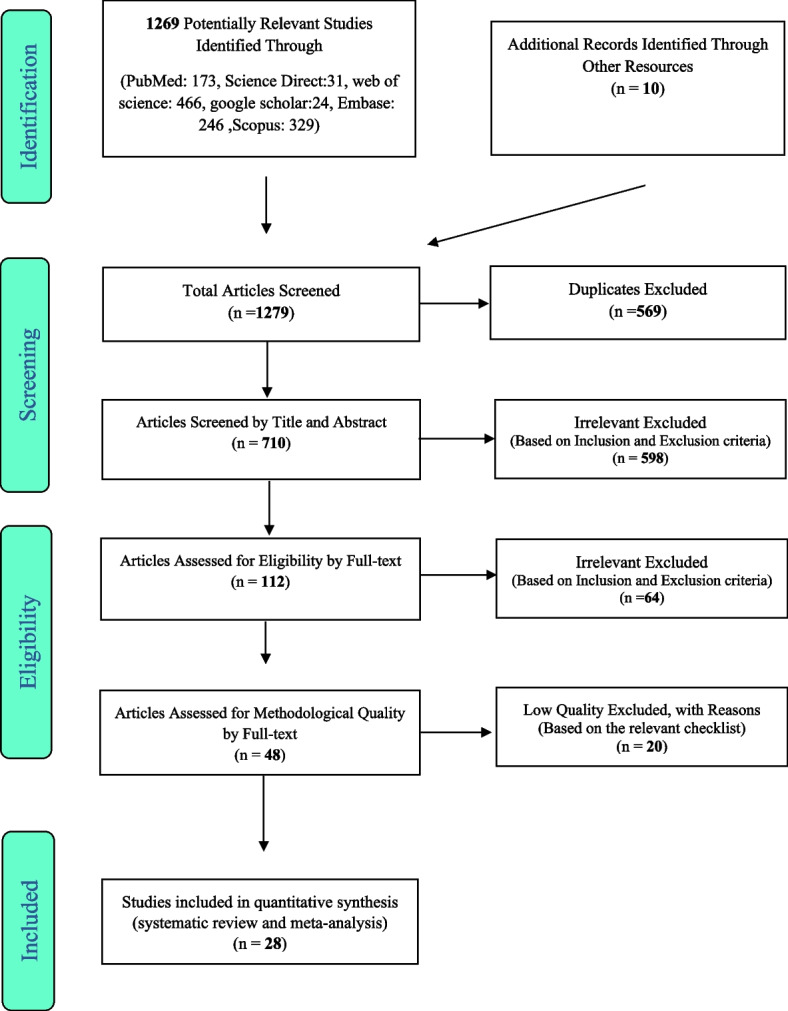
The flowchart on the stages of including the studies in the systematic review and meta-analysis (PRISMA 2009)
Table 1.
Prevalence of back pain in pregnancy
| Author | Year | Reign | Continent | 25 ± 4 | Type of study | pregnant sample size | Number of pregnant with low back pain | Prevalence of low back pain | Instrument |
|---|---|---|---|---|---|---|---|---|---|
| Shijagurumayum Acharya et al. [13] | 2019 | Nepal | Asia | 27.51 ± 5.34 | cross-sectional study | 1284 | 436 | 34 | self-reported questionnaires |
| Ghaderi et al. [14] | 2012 | Iran | Asia | 27.8 ± 5 | cross-sectional study | 235 | 121 | 58.2 | questionnaire-Quebec Back Pain Disability Scale |
| Hollisaz et al. [15] | 2013 | Iran | Asia | 31 ± 7.8 | cross-sectional study | 230 | 146 | 63.5 | questionnaire-Quebec Back Pain Disability Scale |
| Sedighi et al. [16] | 2007 | Iran | Asia | 28.98 ± 5.02 | cross-sectional study | 252 | 71 | 28.4 | interview |
| Rabiee et al. [12] | 2018 | Iran | Asia | 25.83 ± 5.91 | cross-sectional study | 514 | 355 | 69.06 | VAS Scale |
| Manyozo et al. [8] | 2019 | Malawi | Africa | 22.7 ± 4.5 | cross-sectional study | 404 | 249 | 62 | researcher administered questionnaire |
| Skaggs et al. [17] | 2007 | USA | America | 25.98 ± 5.08 | cross-sectional study | 401 | 153 | 38.15 | self-reported questionnaires |
| Mohseni-Bandpei et al. [18] | 2009 | Iran | Asia | 27.1 ± 5.4 | cross-sectional study | 1062 | 427 | 40.2 | self-reported questionnaires |
| Ayanniyi et al. [19] | 2006 | Nigeria | Africa | < 35 | cross-sectional study | 2187 | 669 | 34.9 | researcher administered questionnaire |
| Pierce et al. [20] | 2012 | Australia | Australia | 27.14 ± 5.46 | cross-sectional study | 64 | - | 33 | researcher administered questionnaire |
| Ansari et al. [21] | 2010 | Iran | Asia | 29.88 ± 4.80 | cross-sectional study | 103 | 59 | 57.3 | self-report |
| Mogren et al. [22] | 2005 | Sweden | Europe | 29.05 ± 5.2 | cross-sectional study | 891 | 634 | 71.7 | self-report |
| Al-Sayegh et al. [23] | 2012 | Kuwait | Asia | 25.4 ± 4 | cross-sectional study | 255 | 35 | 13.8 | researcher administered questionnaire |
| Mousavi et al. [24] | 2007 | Iran | Asia | 29.85 ± 3.84 | cross-sectional study | 325 | 91 | 28 | survey questionnaire |
| Starzec et al. [25] | 2019 | Poland | Europe | 23.80 ± 3.20 | cross-sectional study | 189 | 32 | 17 | interview |
| Gupta et al. [26] | 2014 | India | Asia | 28.85 ± 3.87 | cross-sectional study | 227 | 68 | 29.9 | researcher administered questionnaire |
| Rodrigues et al. [27] | 2011 | Brazil | America | 31.5 ± 4.8 | cross-sectional study | 66 | 49 | 75 | self-report |
| Wang et al | 2004 | USA | America | 30.1 ± 4.8 | cross-sectional study | 950 | 42 | 6.5 | self-report |
| Malmqvist et al. [28] | 2012 | Norway | Europe | 35–54 | cross-sectional study | 569 | 124 | 50 | researcher administered questionnaire |
| Stapleton et al. [9] | 2002 | Australia | Australia | 24.24 ± 3.20 | cross-sectional study | 397 | 269 | 68 | questionnaire on demographic |
| Saxena et al. [7] | 2019 | India | Asia | 27.1 ± 9.9 | cross-sectional study | 200 | 162 | 80 | researcher administered questionnaire |
| Mazicioglu et al. [29] | 2006 | Turkey | Asia | 32.8 ± 4.4 | cross-sectional study | 1600 | 734 | 54.1 | self-report |
| Tavares et al. [4] | 2019 | Toronto | America | 27.09 ± 5.66 | cross-sectional study | 343 | 80 | 26.3 | self-report |
| Shafi et al. [30] | 2021 | Pakistan | Asia | 25 ± 4 | cross-sectional study | 160 | 55 | 68.8 | Quebec, Oswestry back pain disability indexes |
In the studies included in Table 2, the highest prevalence of back pain in the first trimester of pregnancy is related to Rabei et al. in Iran in 2018, 63.3% [12], and the lowest prevalence is associated with the study by Weis et al. in Toronto, Canada in 2020 was with 5.9% [31].
Table 2.
Prevalence of back pain in the first trimester of pregnancy
| Author | Year | Reigen | Continent | Age | Type of study | pregnant sample size | Number of pregnants with back pain | Prevalence of back pain | Instrument |
|---|---|---|---|---|---|---|---|---|---|
| Rabiee et al. [12] | 2018 | Iran | Asia | 28.98 ± 5.02 | cross-sectional study | 98 | 62 | 63.3 | VAS Scale |
| Sencan et al. [32] | 2018 | Turkey | Asia | 26.5 ± 5.5 | cross-sectional study | 1500 | 251 | 17.43 | self-report |
| Weis et al. [31] | 2018 | Toronto | America | 28.4 ± 8.4 | cross-sectional study | 287 | 17 | 5.9 | self-report |
| Nazari et al. [33] | 2020 | Iran | Asia | - | cross-sectional study | 550 | 117 | 59.1 | self-report |
In the studies included in Table 3, the highest prevalence of back pain in the second trimester of pregnancy was related to Rabei et al. in 2018, 63.4% [12], and the lowest majority was related to the study by Shijagurumayum et al. in 2019 with 34% [13].
Table 3.
Prevalence of back pain in the second trimester of pregnancy
| Author | Year | Reigen | Continent | Age | Type of study | pregnant sample size | Number of pregnants with back pain | Prevalence of back pain | Instrument |
|---|---|---|---|---|---|---|---|---|---|
| Rabiee et al. [12] | 2018 | Iran | Asia | 28.98 ± 5.02 | cross-sectional study | 145 | 92 | 63.4 | VAS Scale |
| Sencan et al. [32] | 2018 | Turkey | Asia | 26.5 ± 5.5 | cross-sectional study | 1500 | 561 | 37.4 | self-report |
| Shijagurumayum et al. [13] | 2019 | Nepal | Asia | 25 ± 4 | cross-sectional study | 1284 | 437 | 34 | self-reported |
| Stapleton et al. [9] | 2002 | Australia | Australia | - | cross-sectional study | 1120 | 397 | 35.5 | researcher administered questionnaire |
| Weis et al. [31] | 2018 | Toronto | America | 28.4 ± 8.4 | cross-sectional study | 287 | 109 | 38 | self-report |
| Nazari et al. [33] | 2020 | Iran | Asia | - | cross-sectional study | 550 | 110 | 62.85 | self-report |
In the studies in Table 4, the highest prevalence of back pain in the third trimester of pregnancy related to Rabei et al. in 2018 was 74.2% [34], and the lowest majority was related to the study by Tariq et al. in 2018 in Pakistan with 26.3% [35].
Table 4.
Prevalence of back pain in the third trimester of pregnancy
| Author | Year | Reigen | Continent | Age | Type of study | pregnant sample size | Number of pregnants with back pain | Prevalence of back pain | Instrument |
|---|---|---|---|---|---|---|---|---|---|
| Rabiee et al. [34] | 2018 | Iran | Asia | 28.98 ± 5.02 | cross-sectional study | 271 | 201 | 74.2 | VAS Scale |
| Kovacs et al. [36] | 2012 | spain | Europe | 32.25 ± 1.46 | cross-sectional study | 1185 | 825 | 71.3 | self-report |
| Robinson et al. [37] | 2010 | Norway | Europe | 31.3 ± 4.20 | cross-sectional study | 283 | - | 52 | VAS Scale |
| Sencan et al. [32] | 2018 | Turkey | Asia | 26.5 ± 5.5 | cross-sectional study | 1500 | 688 | 45.86 | self-report |
| Khan et al. [38] | 2017 | Pakistan | Asia | 24.56 | cross-sectional | 96 | 66 | 68.8 | researcher administered questionnaire |
| Tariq et al. [35] | 2018 | Pakistan | Asia | 26.30 ± 4.5 | cross-sectional study | 1000 | 263 | 26.3 | researcher administered questionnaire |
| Madadi-Shad et al. [39] | 2018 | Pakistan | Asia | - | cross-sectional study | 560 | 227 | 40.6 | self-report |
| Omoke et al. [40] | 2021 | Nigeria | Africa | 29.33 ± 4.8 | cross-sectional study | 471 | 138 | 58.70 | researcher administered questionnaire |
| Berber et al. [6] | 2020 | Turkey | Asia | 28.09 ± 5.58 | cross-sectional study | 400 | 182 | 45.5 | researcher administered questionnaire |
| Weis et al. [31] | 2018 | Toronto | America | 28.4 ± 8.4 | cross-sectional study | 287 | 161 | 56.1 | self-report |
| Nazari et al. [33] | 2020 | Iran | Asia | - | cross-sectional study | 550 | 123 | 69.49 | self-report |
The global prevalence of back pain during pregnancy
In the review of 28 studies with a sample size of 12,908 people, the I2 heterogeneity test showed high heterogeneity (I2: 98.4) and based on this, we used the random effects method to analyze the results, therefore, based on the meta-analysis, the global prevalence of back pain in 40.5 (95%CI: 33–48.4) during pregnancy was reported (Fig. 2). Also, the study of diffusion bias in the studies through the Egger test shows the absence of publication bias in the analyses (p: 0.949) (Fig. 3).
Fig. 2.
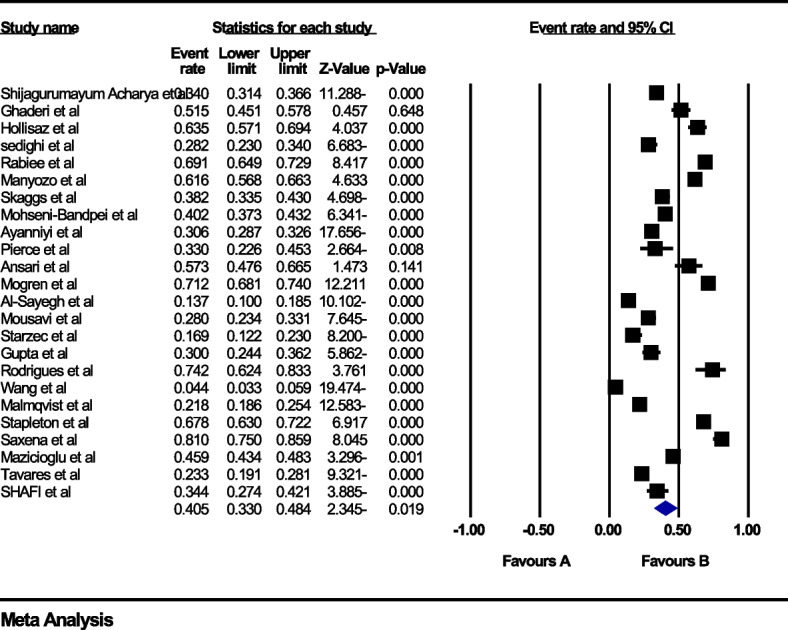
Forest plot of the global prevalence of back pain during pregnancy based on random effects method
Fig. 3.
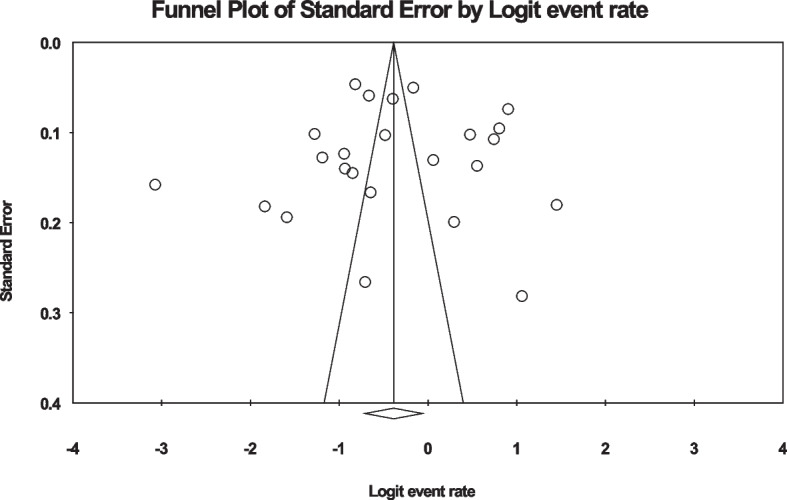
Funnel plot of the publication bias in the reviewed studies
The global prevalence of back pain in the first trimester of pregnancy
In the review of 4 studies with a sample size of 2435 people, the I2 heterogeneity test showed high heterogeneity (I2: 99.1). Based on this, we used the random effects method to analyze the results. Therefore, based on the meta-analysis, the global prevalence of back pain in the first three months of pregnancy was reported as 28.3 (95%CI: 10.5–57.1) (Fig. 4). The analysis of publication bias in the studies through the Egger test shows the absence of publication bias in the studies (p: 0.903) (Fig. 5).
Fig. 4.
Forest plot of the global prevalence of back pain in the first three months of pregnancy based on the random effect's method
Fig. 5.
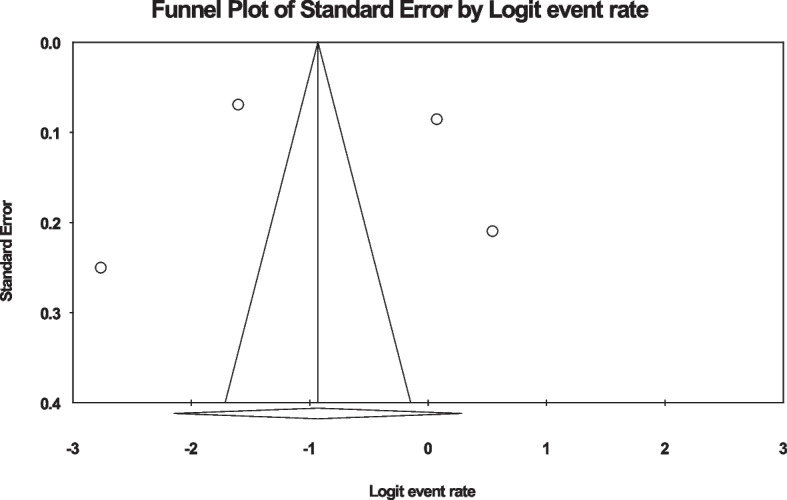
Funnel plot of the distribution bias in the reviewed studies
The global prevalence of back pain in the second trimester of pregnancy
In the review of 6 studies with a sample size of 4886 people, the I2 heterogeneity test showed high heterogeneity (I2: 95.1) and based on this, the random effects method was used to analyze the results, so based on the meta-analysis, the global prevalence of back pain in The second trimester of pregnancy was reported to be 36.8 (95%CI: 30.4–43.7) (Fig. 6). Also, the study of publication bias in the studies through the Egger test shows the absence of publication bias in the studies (p: 0.752) (Fig. 7).
Fig. 6.
Forest plot of the global prevalence of back pain in the second trimester of pregnancy based on the random effect's method
Fig. 7.
Funnel plot of the publication bias in the reviewed studies
The global prevalence of back pain in the third trimester of pregnancy
In the review of 11 studies with a sample size of 6603 people, the I2 heterogeneity test showed high heterogeneity (I2: 98.5), and based on this, the random effects method was used to analyze the results, so based on the meta-analysis, the global prevalence of back pain in During pregnancy, 47.8 (95%CI: 37.2–58.6) was reported (Fig. 8), and the study of diffusion bias in the studies through the Egger test shows the absence of publication bias in the studies (p: 0.885) (Fig. 9).
Fig. 8.
Forest plot of the global prevalence of back pain in the third trimester of pregnancy based on the random effect's method
Fig. 9.
Funnel plot of the publication bias in the reviewed studies
Discussion
The present study is a systematic review and meta-analysis of the global prevalence of back pain in pregnancy. According to the results of the present study, the overall prevalence of back pain in pregnant women was 40.5%.
Back pain is a multi-caused disease that primarily affects active people in society [41]. This disease is the most common cause of activity limitation in people under 45 years of age, the second most common reason for visiting a doctor, and the fifth most common reason for hospitalization, and it has a tremendous negative effect on the financial and economic situation of societies [42].
Back pain is a common symptom in pregnant women. During pregnancy, the body is affected by physiological and hormonal changes due to changes in the structure of the vertebral column and pressure on the nervous system, which causes back pain [4]. Among these changes is the laxity of the ligaments of the sacroiliac joints, lordosis, which causes the body's center of gravity to shift forward, inactivity, fatigue, and stretching of the muscles of the lumbar region, which increases the pressure parallel to the lumbar vertebral ligaments and causes back pain during pregnancy [13, 18].
Gaining weight during pregnancy is ordinary and necessary for the child's growth. Weight gain during this period is usually between 11 and 15 kilos, and the spine must support this body weight. This additional load causes pain in the back. In addition, the weight of the child and the uterus are also growing, and this adds to the pressure on the blood vessels and nerves located in the back and pelvic region [17, 28], which has a higher prevalence of back pain in the third trimester than in the second and first. In our study, it can be due to the same issue, i.e., the more significant increase in the weight of the fetus and mother in the third trimester and the resulting pressure on the mother's back; It has also been mentioned in two studies that the high BMI of the pregnant mother and her excess weight are influential factors for the pregnant woman to suffer from back pain during pregnancy [17, 28].
The exact prevalence of back pain during pregnancy differs in the included studies. Still, their general results are consistent with the finding that pregnant women experience a significant percentage of back pain during pregnancy [4, 18, 31].
A study by Stapleton et al. in Australia on 397 pregnant women reported a prevalence of back pain of 68% [9]. Shijagurumayum Acharya and colleagues also noted in their study on the prevalence of back pain in pregnancy that 34% of pregnant Nepalese women had back pain during pregnancy [13]. In 2021, Shafi et al. conducted a study on 160 pregnant women in Pakistan titled "Prevalence of back pain in pregnancy in women with preeclampsia." Out of 160 people, 55 had back pain during pregnancy. The prevalence of back pain in this study was reported as 68.8% [30]. In 2019, Saxena et al. also conducted a survey titled "Back pain caused by pregnancy in Indian women: prevalence, risk factors and relationship with serum calcium level" on 200 Indian pregnant women with an average age of 9.9 ± 27.1. 80% of pregnancies were reported in these people [7].
In a cross-sectional study conducted by Berber et al. in Turkey in 2020 on 400 pregnant women with an average age of 28.09 ± 5.58, the prevalence of back pain in the third trimester of pregnancy was reported as 45.5% [6]. Rabiee et al. also reported the prevalence of back pain in pregnancy in 63.3% in the first trimester, 63.4% in the second trimester, and 74.2% in the third trimester, which shows the prevalence of back pain during pregnancy is higher in the third trimester [12]. Sencan and colleagues in Turkey reported the prevalence of back pain in pregnancy in the first trimester of pregnancy at 17.43%, in the second trimester of pregnancy at 37.4%, and in the third trimester at 45.86% [32]. Weis et al. also reported the prevalence of back pain in pregnancy at 5.9% in the first trimester, 38% in the second trimester, and 56.1% in the third trimester [31]; According to the results of our study, the above studies also show that the prevalence of back pain during pregnancy is higher in the third trimester.
Back pain during pregnancy is one of the risk factors for back pain after childbirth and can affect different aspects of the sufferers' lives; So, some degrees of movement disorders and insomnia were observed in people suffering from back pain, and the amount of absence from work (in working women) was also reported to be higher [43]. Research shows that in some women, back pain continues in the postpartum period or a new period of back pain begins; the Prevalence of back pain in pregnancy after delivery has been reported in most research to be nearly 40% [9, 13, 31].
In one of the researches, no difference was found in the prevalence of back pain between those who worked inside and outside the home [28]. Still, it was observed that work factors such as heavy work, rotational movements, bending forward and being under pressure in the body position, and back pain after childbirth had an effect [28]. In the study of Hollisaz et al. in 2007 and Ghaderi et al. in 2012, those with a standing job position had a higher probability of back pain [14, 15].
Another study showed a significant relationship between the short height of the mother and back pain during pregnancy [20]. The results of one study showed that long periods of back pain in younger pregnancies cause more prolonged periods of back pain after delivery [16]. Several studies have also investigated the relationship between age and the incidence of back pain during pregnancy, which indicates a direct relationship between the incidence of back pain during pregnancy and increasing age; Back pain is more common among mothers who become pregnant at an older age [7, 14, 20].
Also, those who had a history of back pain in a previous pregnancy were 2.54 times more likely to have back pain in their subsequent pregnancy than those who did not [4, 16]. On the other hand, one of the studies showed that the previous history of the belt, in addition to being a risk factor for back pain after pregnancy, also causes an increase in severity up to six months after delivery [30]. Another study also showed that back pain during pregnancy is not related to back pain before pregnancy but is related to back pain during menstruation and pregnancy [17].
In this study, the prevalence of back pain in the first, second, and third trimesters of pregnancy in Iran was the highest, and one of the reasons for this is that with the increase in the size of the abdomen, pregnant women avoid bending forward to pick up objects [13]. Therefore, they may experience less pain due to a more limited range of motion. This may be the reason for maximum pain in the second trimester and maximum disability in daily activities in the third trimester, also women with more disability often had more pregnancies [13]. While a study also talks about Pregnancy-related transient osteoporosis and finds this factor effective in the effect of pain in the third trimester of pregnancy, Pregnancy-related transient osteoporosis of the hip is a rare condition that manifests with sudden pain located in the groin. region, anterior thigh, and buttocks. It occurs during the third trimester of pregnancy or less frequently during the post-partum period [44, 45].
A study has also reported that the sitting or standing position during the first stage of labor causes an 80% reduction in continuous back pain and a 50% reduction in back pain with contractions. Also, sitting is more comfortable in the late first and second stages of labor [23]. Also, in Mohseni-Bandpei et al.'s study, pregnant women with better general health conditions reported lower back pain intensity [18]. In general, as mentioned, in line with the results of the present study, back pain is a common complication in pregnant mothers, especially in the third trimester of pregnancy. Also, the prevalence of back pain in pregnant women differs in the reviewed studies. This difference may be due to the use of different tools, its dependence on the report of pain, and various factors that play a role in the occurrence of this complication.
Limitations
One of the limitations of this meta-analysis is that the included studies were limited to research published in English, which means that studies in other languages may have needed to be addressed. In addition, several studies were excluded due to low quality, for example, not reporting prevalence or low sample size.
Conclusion
According to the results of the present study, the overall prevalence of back pain in pregnancy is 40.5%, which is a significant result and a high prevalence, so the results obtained from the study can be used as the final criteria for proper prevention and treatment planning, and health policymakers can use the results of the present meta-analysis to pay more attention to the complication of back pain during pregnancy, to evaluate this complication and its consequences on the health of pregnant mothers who are part of the active population of the society; Use it as a research priority and implement optimal solutions to prevent and improve this disease.
Acknowledgements
By Student Research Committee of Kermanshah University of Medical Sciences.
Abbreviations
- RLS
Restless legs syndrome
- STROBE
Strengthening the Reporting of Observational studies in Epidemiology
- PRISMA
Preferred Reporting Items for Systematic Reviews and Meta-Analysis
Authors’ contributions
NS and AM contributed to the design, MM statistical analysis, participated in most of the study steps. MM and AM and RH and MH and SK and SHSH prepared the manuscript. All authors have read and approved the content of the manuscript.
Funding
By Deputy for Research and Technology, Kermanshah University of Medical Sciences (IR) (4020213). This deputy has no role in the study process.
Availability of data and materials
Datasets are available through the corresponding author upon reasonable request.
Declarations
Ethics approval and consent to participate
Ethics approval was received from the ethics committee of deputy of research and technology, Kermanshah University of Medical Sciences (IR.KUMS.REC.1401.541).
Consent for publication
Not applicable.
Competing interests
The authors declare no competing interests.
Footnotes
Publisher's Note
Springer Nature remains neutral with regard to jurisdictional claims in published maps and institutional affiliations.
References
- 1.Liu X, Xu Z, Wang Y, Luo H, Zou D, Zhou Z, et al. Evaluating the quality of reports about randomized controlled trials of acupuncture for low back pain. J Pain Res. 2021;14:1141. doi: 10.2147/JPR.S308006. [DOI] [PMC free article] [PubMed] [Google Scholar]
- 2.Citko A, Górski S, Marcinowicz L, Górska A. Sedentary lifestyle and nonspecific low back pain in medical personnel in North-East Poland. BioMed Res Int. 2018;2018:1965807. doi: 10.1155/2018/1965807. [DOI] [PMC free article] [PubMed] [Google Scholar]
- 3.Kalinowski P, Krawulska A. Kinesio taping vs. placebo in reducing pregnancy-related low back pain: a cross-over study. Med Sci Monit. 2017;23:6114–20. doi: 10.12659/MSM.904766. [DOI] [PMC free article] [PubMed] [Google Scholar]
- 4.Tavares P, Barrett J, Hogg-Johnson S, Ho S, Corso M, Batley S, et al. Prevalence of low back pain, pelvic girdle pain, and combination pain in a postpartum Ontario population. J Obstet Gynaecol Canada. 2020;42:80–473. doi: 10.1016/j.jogc.2019.08.030. [DOI] [PubMed] [Google Scholar]
- 5.Heuch I, Heuch I, Hagen K, Storheim K, Zwart J-A. Associations between the number of children, age at childbirths and prevalence of chronic low back pain: the Nord-Trøndelag Health Study. BMC Public Health. 2020;20(1):1–11. doi: 10.1186/s12889-020-09480-0. [DOI] [PMC free article] [PubMed] [Google Scholar]
- 6.Berber MA, Satılmış İG. Characteristics of Low Back Pain in Pregnancy, Risk Factors, and Its Effects on Quality of Life. Pain Manag Nurs. 2020;21(6):579–586. doi: 10.1016/j.pmn.2020.05.001. [DOI] [PubMed] [Google Scholar]
- 7.Saxena AK, Chilkoti GT, Singh A, Yadav G. Pregnancy-induced low back pain in Indian women: Prevalence, risk factors, and correlation with serum calcium levels. Anesth Essays Res. 2019;13(2):395. doi: 10.4103/aer.AER_196_18. [DOI] [PMC free article] [PubMed] [Google Scholar]
- 8.Manyozo S. Low back pain during pregnancy: Prevalence, risk factors and association with daily activities among pregnant women in urban Blantyre Malawi. Malawi Med J. 2019;31(1):71–76. doi: 10.4314/mmj.v31i1.12. [DOI] [PMC free article] [PubMed] [Google Scholar]
- 9.Stapleton DB, MacLennan AH, Kristiansson P. The prevalence of recalled low back pain during and after pregnancy: a South Australian population survey. Aust N Z J Obstet Gynaecol. 2002;42(5):482–485. doi: 10.1111/j.0004-8666.2002.00482.x. [DOI] [PubMed] [Google Scholar]
- 10.Ceprnja D, Chipchase L, Fahey P, Liamputtong P, Gupta A. Prevalence and factors associated with pelvic girdle pain during pregnancy in Australian women: a cross-sectional study. Spine. 2021;46(14):944. doi: 10.1097/BRS.0000000000003954. [DOI] [PMC free article] [PubMed] [Google Scholar]
- 11.Al-Hadidi F, Bsisu I, Haddad B, AlRyalat SA, Shaban M, Matani N, et al. The prevalence of low back pain among female hospital staff at childbearing age. PeerJ. 2020;8:e9199. doi: 10.7717/peerj.9199. [DOI] [PMC free article] [PubMed] [Google Scholar]
- 12.Rabiee M, Sarchamie N. Low back pain severity and related disability in different trimesters of pregnancy and risk factors. Int J Womens Health Reprod Sci. 2018;4:438–443. doi: 10.15296/ijwhr.2018.73. [DOI] [Google Scholar]
- 13.Shijagurumayum Acharya R, Tveter AT, Grotle M, Eberhard-Gran M, Stuge B. Prevalence and severity of low back-and pelvic girdle pain in pregnant Nepalese women. BMC Pregnancy Childbirth. 2019;19(1):1–11. doi: 10.1186/s12884-019-2398-0. [DOI] [PMC free article] [PubMed] [Google Scholar]
- 14.Ghaderi F, Asghari-Jafarabadi M, Mohseni-Bandpei MA. Prevalence and associated factors of musculoskeletal pain in pregnancy. J Health Care. 2012;14(3):55–62.
- 15.Holisaz M, Kashani ZN, Shams AA, Hosseini SM. Study of prevalence of low back pain in pregnant weman referring to department of Gynecology & Obstetrics of Baqiyatallah hospital. JAUMS. 2007;5:1293–1297. [Google Scholar]
- 16.Sedghi A, Moradi A, Ostad RA, Lotfinia I, Zarghami N. Prevalence of low back pain among women of fertility age in Tabriz and the related risk factors. Med J Tabriz Uni Med Sci Health Serv. 2008;30(2):87–91. [Google Scholar]
- 17.Skaggs CD, Prather H, Gross G, George JW, Thompson PA, Nelson DM. Back and pelvic pain in an underserved United States pregnant population: a preliminary descriptive survey. J Manipul Physiol Ther. 2007;30(2):130–134. doi: 10.1016/j.jmpt.2006.12.008. [DOI] [PubMed] [Google Scholar]
- 18.Mohseni-Bandpei MA, Fakhri M, Ahmad-Shirvani M, Bagheri-Nessami M, Khalilian AR, Shayesteh-Azar M, et al. Low back pain in 1,100 Iranian pregnant women: prevalence and risk factors. Spine J. 2009;9(10):795–801. doi: 10.1016/j.spinee.2009.05.012. [DOI] [PubMed] [Google Scholar]
- 19.Ayanniyi O, Sanya A, Ogunlade S, Oni-Orisan M. Prevalence and pattern of back pain among pregnant women attending ante-natal clinics in selected health care facilities. Afr J Biomed Res. 2006;9(3). 10.4314/ajbr.v9i3.48898
- 20.Pierce H, Homer CS, Dahlen HG, King J. Pregnancy-related lumbopelvic pain: listening to Australian women. Nursing research and practice. 2012;2012:387428. doi: 10.1155/2012/387428. [DOI] [PMC free article] [PubMed] [Google Scholar]
- 21.Ansari NN, Hasson S, Naghdi S, Keyhani S, Jalaie S. Low back pain during pregnancy in Iranian women: Prevalence and risk factors. Physiother Theory Pract. 2010;26(1):40–48. doi: 10.3109/09593980802664968. [DOI] [PubMed] [Google Scholar]
- 22.Mogren IM, Pohjanen AI. Low back pain and pelvic pain during pregnancy: prevalence and risk factors. Spine. 2005;30(8):983–991. doi: 10.1097/01.brs.0000158957.42198.8e. [DOI] [PubMed] [Google Scholar]
- 23.Al-Sayegh NA, Salem M, Dashti LF, Al-Sharrah S, Kalakh S, Al-Rashidi R. Pregnancy-related lumbopelvic pain: prevalence, risk factors, and profile in Kuwait. Pain Med. 2012;13(8):1081–1087. doi: 10.1111/j.1526-4637.2012.01424.x. [DOI] [PubMed] [Google Scholar]
- 24.Mousavi SJ, Parnianpour M, Vleeming A. Pregnancy related pelvic girdle pain and low back pain in an Iranian population. Spine. 2007;32(3):E100–E104. doi: 10.1097/01.brs.0000254123.26649.6e. [DOI] [PubMed] [Google Scholar]
- 25.Starzec M, Truszyńska-Baszak A, Tarnowski A. Pregnancy-related lumbar and pelvic girdle pain in Polish women. Clin Exp Obstet Gynecol. 2018;45(2):194–197. doi: 10.12891/ceog4090.2018. [DOI] [Google Scholar]
- 26.Gupta M, Srivastava S, Khan S. Prevalence of pregnancy related pelvic girdle pain in Indian primigravida: a tertiary care hospital based study. Indian J Obstet Gynecol Res. 2014;1(1):16–23. [Google Scholar]
- 27.Carregaro RL, Tottoli CR, Rodrigues DdS, Bosmans JE, da Silva EN, van Tulder M. Low back pain should be considered a health and research priority in Brazil: Lost productivity and healthcare costs between 2012 to 2016. PLoS One. 2020;15(4):e0230902. doi: 10.1371/journal.pone.0230902. [DOI] [PMC free article] [PubMed] [Google Scholar]
- 28.Malmqvist S, Kjaermann I, Andersen K, Økland I, Brønnick K, Larsen JP. Prevalence of low back and pelvic pain during pregnancy in a Norwegian population. J Manipulative Physiol Ther. 2012;35(4):272–278. doi: 10.1016/j.jmpt.2012.04.004. [DOI] [PubMed] [Google Scholar]
- 29.Mazicioglu M, Tucer B, Ozturk A, Serin IS, Koc H, Yurdakos K, et al. Low back pain prevalence in Turkish pregnant women. J Back Musculoskelet Rehabil. 2006;19(2–3):89–96. doi: 10.3233/BMR-2006-192-308. [DOI] [Google Scholar]
- 30.Shafi P, Khan R, Ahmad T, Zeb SA, Sajjad A. Prevalence of Lower Back Pain in Pregnant Women with Pre-Eclampsia. age (weeks).33(7.41):32.47–8.33.
- 31.Weis CA, Pohlman K, Draper C, Stuber K, Hawk C. Chiropractic care for adults with pregnancy-related low back, pelvic girdle pain, or combination pain: a systematic review. J Manipul Physiol Ther. 2020;43(7):714–731. doi: 10.1016/j.jmpt.2020.05.005. [DOI] [PubMed] [Google Scholar]
- 32.Sencan S, Ozcan-Eksi EE, Cuce I, Guzel S, Erdem B. Pregnancy-related low back pain in women in Turkey: prevalence and risk factors. Ann Phys Rehabil Med. 2018;61(1):33–37. doi: 10.1016/j.rehab.2017.09.005. [DOI] [PubMed] [Google Scholar]
- 33.Nazari B, Esfahlani MZ, Dorosti A, Mirzaei F. Prevalence and risk factors for low back pain in Primiparous women visiting maternity hospitals during different months of pregnancy. Int J Women's Health Reprod Sci (IJWHR) 2020;8(4):401–405. [Google Scholar]
- 34.Rabiee M, Sarchamiee N. Frequency of low back pain in each pregnancy trimester and its related factors in pregnant women visiting Shaheed Mostafa Khomeini hospital in 2015. Iran J Obstet Gynecol Infertil. 2018;20(12):32–39. [Google Scholar]
- 35.Tariq N, Javed MA, Siddique NA, Zafar A, Hussain MA. Prevalence of disability levels of low back pain and associated factors among heavy vehicle transport drivers. Ann Med Health Sci Res. 2022;12(S1):143–146. [Google Scholar]
- 36.Kovacs FM, Garcia E, Royuela A, González L, Abraira V. Prevalence and factors associated with low back pain and pelvic girdle pain during pregnancy: a multicenter study conducted in the Spanish National Health Service. Spine (Phila Pa 1976) 2012;37(17):1516–336. doi: 10.1097/BRS.0b013e31824dcb74. [DOI] [PubMed] [Google Scholar]
- 37.Robinson HS, Mengshoel AM, Veierød MB, Vøllestad N. Pelvic girdle pain: potential risk factors in pregnancy in relation to disability and pain intensity three months postpartum. Man Ther. 2010;15(6):522–528. doi: 10.1016/j.math.2010.05.007. [DOI] [PubMed] [Google Scholar]
- 38.Khan MJ, Israr A, Basharat I, Shoukat A, Mushtaq N, Farooq H. Prevalence of pregnancy related low back pain in third trimester and its impact on quality of life and physical limitation. J Islam Int Med Coll (JIIMC) 2017;12(1):39–43. [Google Scholar]
- 39.Madadi-Shad M, Jafarnezhadgero AA, Sheikhalizade H, Dionisio VC. Effect of a corrective exercise program on gait kinetics and muscle activities in older adults with both low back pain and pronated feet: a double-blind, randomized controlled trial. Gait Posture. 2020;76:339–345. doi: 10.1016/j.gaitpost.2019.12.026. [DOI] [PubMed] [Google Scholar]
- 40.Omoke N, Amaraegbulam P. Low back pain as seen in orthopedic clinics of a Nigerian Teaching Hospital. Niger J Clin Pract. 2016;19(2):212–217. doi: 10.4103/1119-3077.175964. [DOI] [PubMed] [Google Scholar]
- 41.Melzack R, Bélanger E. Labour pain: correlations with menstrual pain and acute low-back pain before and during pregnancy. Pain. 1989;36(2):225–229. doi: 10.1016/0304-3959(89)90027-4. [DOI] [PubMed] [Google Scholar]
- 42.Sehmbi H, D'Souza R, Bhatia A. Low back pain in pregnancy: investigations, management, and role of neuraxial analgesia and anaesthesia: a systematic review. Gynecol Obstet Invest. 2017;82(5):417–436. doi: 10.1159/000471764. [DOI] [PubMed] [Google Scholar]
- 43.Bergström C, Persson M, Mogren I. Pregnancy-related low back pain and pelvic girdle pain approximately 14 months after pregnancy–pain status, self-rated health and family situation. BMC Pregnancy Childbirth. 2014;14(1):1–12. doi: 10.1186/1471-2393-14-48. [DOI] [PMC free article] [PubMed] [Google Scholar]
- 44.Quaresima P, Angeletti M, Luziatelli D, Luziatelli S, Venturella R, Di Carlo C, Bernardo S. Pregnancy associated transient osteoporosis of the hip (PR-TOH): A non-obstetric indication to caesarean section. A case report with literature review. Eur J Obstet Gynecol Reprod Biol. 2021;262:28–35. doi: 10.1016/j.ejogrb.2021.05.007. [DOI] [PubMed] [Google Scholar]
- 45.Wang S-M, Dezinno P, Maranets I, Berman MR, Caldwell-Andrews AA, Kain ZN. Low back pain during pregnancy: prevalence, risk factors, and outcomes. Obstet Gynecol. 2004;104(1):65–70. doi: 10.1097/01.AOG.0000129403.54061.0e. [DOI] [PubMed] [Google Scholar]
Associated Data
This section collects any data citations, data availability statements, or supplementary materials included in this article.
Data Availability Statement
Datasets are available through the corresponding author upon reasonable request.



